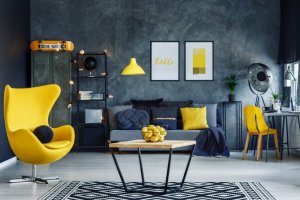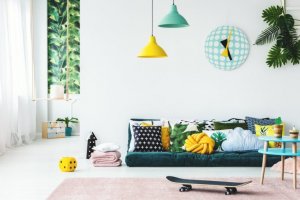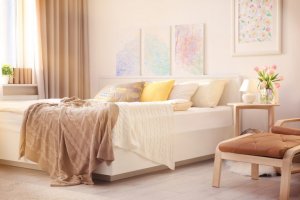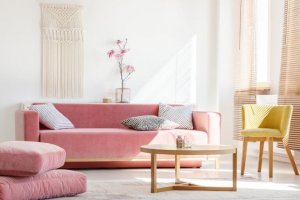Interior Decor And The Psychology of Color

The human mind is one of nature’s most wonderful and complex machines. The way we perceive the world and how it affects us emotionally can also have an impact on how we act and behave. The psychology of color attempts to study and understand these concepts in greater depth.
Color is a form of non-verbal communication and is widely used in interior design. Understanding this concept will help you to better plan the decor in your home so that each room looks and feels exactly how you want it.
If you’re thinking about giving your home a new look but you can’t quite decide which colors to use, this is the article for you. Before you decide on your color palette, you’ll need to think carefully about what you want to achieve in each room, and how you want your home to feel. This is the key to successful decor. Today, we’ll tell you the basic principles behind the psychology of color.
Dramatic reds

Red is one of the warmest colors. It invigorates, stimulates the senses, and whets the appetite. That’s why you’ll often find it in classical style dining rooms, and even kitchens. When used correctly, red can be a fantastic option for your home.
However, you have to be careful when using this color. Out of context, and in rooms designed for rest (such as bedrooms), red simply doesn’t work. Intense and vibrant, it can increase feelings of agitation and irritability.
The psychology of color – yellows

Yellow is the color of optimism and happiness. It’s warm, bright and full of energy. It’s one of the most eye-catching colors and draws a lot of attention when used in interiors. Yellow is a color that inspires creativity, new ideas, and helps us find solutions.
Once again, however, it’s important to be careful with how you use it. Too much yellow can strain your eyes, causing feelings of frustration. Another curious fact is that babies seem to cry more when they spend time in yellow rooms. With this in mind, it’s best to use it sparingly if you want to incorporate it into your decor.
Blues and greens

Blue is the color of peace. When paired with white, it promotes intelligence and concentration. While it has several other connotations, in interior decor, it’s generally used in spaces where designers want to promote mental clarity, order, and calm.
Greens have a similar effect but are more often associated with nature and the great outdoors. Any touches of green in your home create a direct link with Mother Nature. In many cases, its effects are even more soothing and calming than blue.
Neutral colors

Together with black and white, browns, beiges, creams and grays are all neutral colors. Brown is a mixture of several different colors and is a symbol of the earth, roots, and origins. In decoration, it can be used to create a sense of harmony and serves to complement other colors.
Beiges and creams are reliable, discreet, elegant and versatile. Beige tones, in particular, are known to be particularly neutral, calming and soothing. One of the advantages of using beige in your decor is that its emotional impact can change depending on the color you combine it with. This is why it’s so often used as a background color in homes, as it helps to determine the overall feeling in the room.
The psychology of color – express your feelings through paint

Understanding the psychological implications of each color will help you plan your home interior more reflectively and less impulsively so that you don’t rely solely on personal taste. While your taste is important, it can limit the color combinations you try out in your home.
A greater understanding of the power colors have over our emotional state can be a fantastic tool for shaping our moods, and the moods of those around us. Start by deciding which color you want to imagine when you’re in each room. One last tip – try to make sure that green is one of them. It will make a fantastic addition to your home.
The human mind is one of nature’s most wonderful and complex machines. The way we perceive the world and how it affects us emotionally can also have an impact on how we act and behave. The psychology of color attempts to study and understand these concepts in greater depth.
Color is a form of non-verbal communication and is widely used in interior design. Understanding this concept will help you to better plan the decor in your home so that each room looks and feels exactly how you want it.
If you’re thinking about giving your home a new look but you can’t quite decide which colors to use, this is the article for you. Before you decide on your color palette, you’ll need to think carefully about what you want to achieve in each room, and how you want your home to feel. This is the key to successful decor. Today, we’ll tell you the basic principles behind the psychology of color.
Dramatic reds

Red is one of the warmest colors. It invigorates, stimulates the senses, and whets the appetite. That’s why you’ll often find it in classical style dining rooms, and even kitchens. When used correctly, red can be a fantastic option for your home.
However, you have to be careful when using this color. Out of context, and in rooms designed for rest (such as bedrooms), red simply doesn’t work. Intense and vibrant, it can increase feelings of agitation and irritability.
The psychology of color – yellows

Yellow is the color of optimism and happiness. It’s warm, bright and full of energy. It’s one of the most eye-catching colors and draws a lot of attention when used in interiors. Yellow is a color that inspires creativity, new ideas, and helps us find solutions.
Once again, however, it’s important to be careful with how you use it. Too much yellow can strain your eyes, causing feelings of frustration. Another curious fact is that babies seem to cry more when they spend time in yellow rooms. With this in mind, it’s best to use it sparingly if you want to incorporate it into your decor.
Blues and greens

Blue is the color of peace. When paired with white, it promotes intelligence and concentration. While it has several other connotations, in interior decor, it’s generally used in spaces where designers want to promote mental clarity, order, and calm.
Greens have a similar effect but are more often associated with nature and the great outdoors. Any touches of green in your home create a direct link with Mother Nature. In many cases, its effects are even more soothing and calming than blue.
Neutral colors

Together with black and white, browns, beiges, creams and grays are all neutral colors. Brown is a mixture of several different colors and is a symbol of the earth, roots, and origins. In decoration, it can be used to create a sense of harmony and serves to complement other colors.
Beiges and creams are reliable, discreet, elegant and versatile. Beige tones, in particular, are known to be particularly neutral, calming and soothing. One of the advantages of using beige in your decor is that its emotional impact can change depending on the color you combine it with. This is why it’s so often used as a background color in homes, as it helps to determine the overall feeling in the room.
The psychology of color – express your feelings through paint

Understanding the psychological implications of each color will help you plan your home interior more reflectively and less impulsively so that you don’t rely solely on personal taste. While your taste is important, it can limit the color combinations you try out in your home.
A greater understanding of the power colors have over our emotional state can be a fantastic tool for shaping our moods, and the moods of those around us. Start by deciding which color you want to imagine when you’re in each room. One last tip – try to make sure that green is one of them. It will make a fantastic addition to your home.







